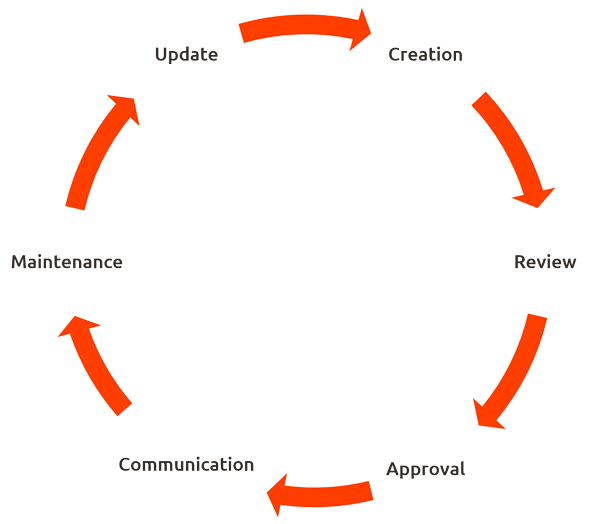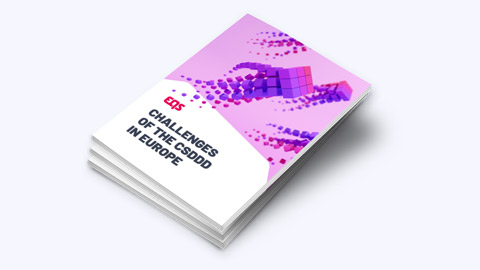Stress-free Policy Management: 5 Tips
We'll show you how to stay on top of your policies.

Every company has a wide variety of policies in circulation, such as workplace health and safety guidelines or data protection policies. Often, however, these policies are out-of-date and are rarely read by employees. And yet policies are supposed to significantly reduce a company’s compliance risks.
Guidelines help to minimize liability risks
Companies across the world want to minimize risk to maintain their reputation and protect themselves from financial loss. At the same time the number of legal regulations that companies are required to implement is increasing. In order to ensure compliance, many companies rely on measures such as workplace policies. These policies clearly define acceptable and unacceptable behavior in the workplace in order to communicate internal and legal requirements to employees and thus reduce risk. If a company can demonstrate that employees are aware of these policies and understand their content, they can reduce their liability risk.
Policy Chaos in Companies Increases with Every New Regulation
However, what may seem simple at first becomes a problem in many companies over time: as the number of regulations increases, so does the number of policies in the company and it becomes increasingly difficult to maintain an overview. If there is no central system for managing these policies and the associated work processes (such as approval, updating, versioning, etc.), outdated, inconsistent or unauthorized policies often end up in circulation. Often poor policy communication means that few people actually read or understand the policies.

Companies have to demonstrate that employees are aware of internal policies and understand their content.
A Policy Life Cycle to Minimize Risk
It is essential to consider a uniform approach to current and future policies so that compliance measures can be successfully implemented and risks are reduced. In the following points we explain the most important steps in establishing well-structured policy management based on the “Policy Life Cycle”.

The six steps of a Policy Life Cycle
1. Create Consistent Templates
As a first step it is vital to create templates for your policies to ensure a consistent writing style, layout, and structure for all future policies. While it may sound strange, many companies have a policy on how to write policies to ensure policies remain consistent, particularly when there are numerous policy authors. It is also advisable to revise all existing policies using the new templates.
When drafting new policies, try to include both internal and external sources of information. Ensure that the policies include directives and industry standards in a way that is easy understand and digest. You should also include feedback from your employees.
2. Review and Approve
Ensure that each policy is carefully reviewed before publication. They should be accurate while still being easy for employees to understand. The comments or changes made by everyone involved in the drafting process should be documented in detail. Once the final policy is in place it should be approved by management.
3. Communicate
Send the policy to the relevant employees and ensure that all new employees also receive it at the start of their employment. As a next step request that every employee confirms that they have read and understood the policy . Ideally this would be done electronically. If the employee fails to confirm, they should receive reminders or additional training material.
4. Maintain & Update
Policy management is a continuous process. Accordingly we recommend that you regularly review each policy for its effectiveness and whether it is still up-to-date. If a revision is necessary, the policy should go through all the steps in the policy life cycle once again.
5. How Digital Policy Management Systems Can Help You
In order to process the policies efficiently, a digital policy management system is essential. It helps to maintain an overview and save time.
1. Centralize Your Policy Management
A digital policy management tool centrally manages all policies relevant to your employees as well as standards and process documentation. This allows you to keep track of all documents at all times. You can also link policies to each other or insert categorizations. Centralized management is not only beneficial for those responsible for policies. It also makes it easier for employees to find the policy they are looking for.
2. Standardize the Policy Creation Process
By storing templates in a policy management system, you standardize the structure and layout of all policies. Role and authorization management also simplifies collaboration between all those involved in policy creation (e.g. owners, authors, and approvers).
3. Reach All Employees with Just One Click
A digital policy management tool simplifies the sending of policies to new and existing employees. Once an employee has read and understood the policy, he or she can easily confirm within the system. A connection to your HR system ensures that your employees’ data is always up-to-date.
4. Save Time Through Automation
Manually managing policies is possible, but time consuming. You can use a policy management system to automate policy versioning and archiving. Automatic reminders can also be stored in the system. For example, you can send reminders to employees who have not yet read and confirmed a policy. It is also possible to set reminders to update policies at regular intervals.
5. Measure and Increase the Effectiveness of Policies
With policy management software you can create complete and audit-proof reports on policy confirmation rates at the touch of a button. Improve your employees’ understanding of the policy (and consequently the rate of compliance) by adding additional training material, such as tutorials or videos, to the policy management system.
A digital policy management system supports policy owners at every step of the policy life cycle. This saves time and improves the quality of your policy management.
Conclusion
Customize this process to your organization and ensure that each policy is written and updated in accordance with your policy lifecycle. In this way you can positively influence the behavior of your employees in the workplace and reduce compliance risks over the long-term.

How to effectively create, implement and communicate compliance policies and measure the success of your policy program – for everyone who is responsible for Compliance policies in their organization





